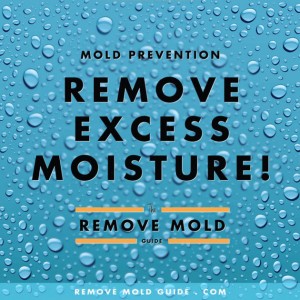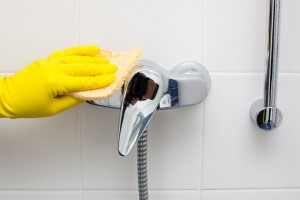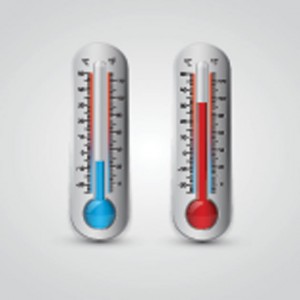Best Ways to Prevent Mold in Your Home
There are four major factors in mold prevention:
- Moisture/Dampness
- Humidity
- Cleanliness
- Temperature
1) Minimize Moisture and Damp Surfaces
It doesn’t take much time to walk through your house and identify the sources of moisture and damp surfaces. It might be a leaky pipe, ground water seeping through your foundation wall, or cracked caulk on window seals. Whatever the sources are, they need to be addressed as soon as possible. Typically, if a wet material is dried out within 48 hours, the risk of mold exposure is very minimal. So the watch word for addressing damp surfaces is ACT QUICKLY to fix the problem or dry up the wet material.
Here are some general steps to take to minimize moisture and dampness in your home:
- Fix roof leaks immediately
- Make sure air conditioning unit drip pans and condensation drains are clean and unobstructed
- Ensure windows do not have cracked or missing caulk around the edges. This allows more rainwater to seep in.
- Keep rain gutters clean and unobstructed
- Make sure the ground around your foundation slopes away from the house. This keep rain water from infiltrating your basement walls. (Be sure not to direct rainwater directly into your neighbor’s basement.)
- Keep air circulating and dry. This helps the damp areas to dry out through evaporation.
- Insulate cold surfaces such as cold pipes. This reduces or eliminates the condensation that can collect over time and serve as a breeding ground for mold.
- If nothing else, running a fan will get air flowing in the room and will aid in promoting evaporation on the damp surface.

A hygrometer is an instrument used to measure moisture content in the air, typically by percentage of relative humidity.
2) Keep Humidity at Optimal Levels
Since mold spores love damp environments, high humidity creates an environment where mold can settle in and start growing. According to the U.S. EPA, your home should have a relative humidity between 30% and 50%. How do you measure the humidity in your home you ask? With a hygrometer, of course. A hygrometer is small device that can be placed in the room of which your are measuring. You can find them at many hardware stores, or you can order one online from our equipment page, mostly for around $15 to $30. Many models also include a thermometer.
Although hygrometers are handy, and they give you an accurate measurement of the moisture content in the air of your home, here are some things you can do to ensure your humidity levels do get too high, even if you don’t have a measuring device:
- Run a dehumidifier and/or your air conditioning system (central air units). Be aware, however, that water-based cooling systems, such as swamp coolers actually increase humidity in the home. So only systems with forced air or central air will reduce humidity.
- Use the exhaust fan or open windows in your bathroom while showering. This minimizes the water vapor that spills into the hallway when you exit the shower.
- Make sure that water vapor producing appliances, such as dryers and stoves, are ventilated outside of the house.
- On a related note, run the exhaust fan above the stove while cooking. If the fan vents outside of the house, then this will help. Some fans just push the air through a filter, then back into the kitchen.
- Put plastic over dirt floors to reduce ground-based water vapor from rising up into the home.
3) Clean Frequently
Its been said that cleanliness is next to godliness. While this may be true, cleanliness will also prevent mold from growing in your home. Now that’s heavenly, right! Here are some tips on where to focus your cleaning in order to prevent mold growth:
- Apply a detergent for non-pourous surfaces, such as your shower, bath tub, sink, and similar surfaces and give it a light scrub. A regular cleaning schedule, depending on the situation, will go a long way in preventing mold in the bathroom, which is a common place for growth to occur.
- Places where food scraps or crumbs collect should be routinely cleaned up. Remember mold is a decomposer, and any organic material that rots will bring mold with it.
- Wipe down walls and ceilings that experience frequent condensation buildup. Be sure to read the labels of cleaners to ensure you are using them properly. This applies to basement walls and floors too.
- Remove the dust and dirt on surfaces that experience condensation. Common surfaces include cold pipes and window sashes.
The recommended frequency of cleaning depends on various factors, including the amount of human traffic an area has, the type of activity that takes place, and the ambient environment (humidity, temperature, etc). For example, a bathroom used by one person may only need to be cleaned every 2 or 3 weeks , while a bathroom being used by three or four people might need a cleaning every 1 or 2 weeks. or so.
Bonus tip: Use the appropriate paint on the walls and ceiling. Special paints have been created specifically for bathrooms and kitchens because of the moist environments in these rooms. These paints help prevent growth of mold.
4) Regulate Temperature.
Although cold air is typically drier than warm air, warm air will create more evaporation and help keep things dry because it can have a lower relative humidity.
For example, if you take two rooms with the same amount of water vapor in the air, except one room is at 50 F degrees while the other is at 70 F degrees. The 70 F room will have a lower relative humidity, and therefore feel drier than the 50 F room. That is because warmer air can hold more water vapor, and is ready to absorb more water from the damp surfaces in the room (through evaporation). So by increasing the temperature in the house, you are building more capacity for the air to absorb water from damp areas. Keep in mind, however, that you also want to move that air so the water vapor doesn’t just build up and create a steamy, wet environment in the house. You can do this by using a fan or by running your furnace fan with windows open (unless it is really cold outside, which would drop the temperature inside the home).




